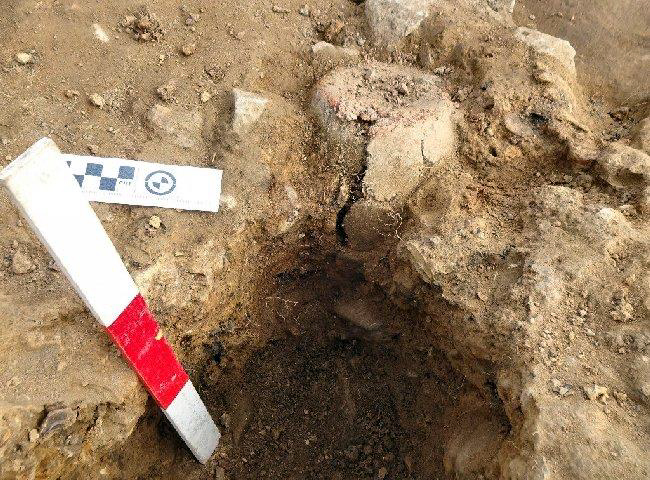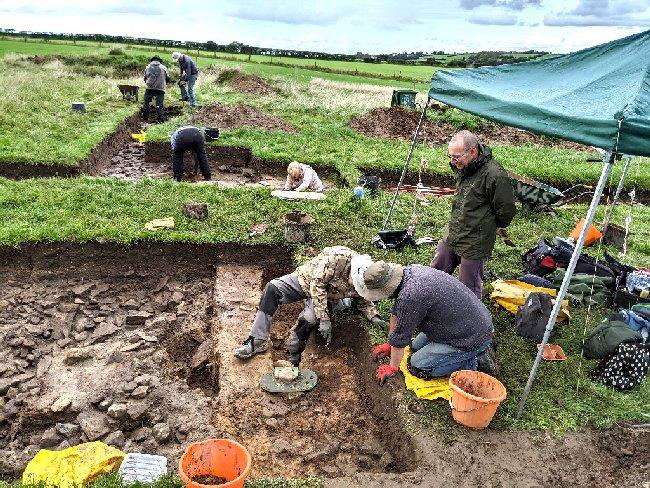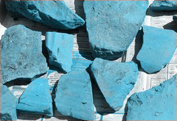
Another exciting month at our Aspull site with the discovery of another ancient urn. This time, although a lot smaller, our find seems to be intact, positioned upside down and embedded in a mound of sandy clay. Our excavations have revealed that this mound is situated under the mottled clay and burnt layers which cover most of the central area (the burnt layer, as reported in our last Newsletter, is defined by the thin red and black line). This is significant, as our first urn is lying in a pit cut into the mottled clay layer which proves that this latest pot must pre-date it. This also conveniently fits with the style of each vessel i.e., this latest being much smaller in diameter than the first. It's in a very fragile condition so we are going to leave it buried in the sandy clay until we can organise somewhere for it to be studied and a place for it to finally reside. However we can already see it has an incised crisscross pattern on it. This, together with its size, suggests it's a type of pot known as a beaker which possible dates it earliest period of the Bronze Age.
The main thrust of this years work has been to establish the nature and extent of the central mound. This we have done to a large extent by initially extending Trench 1 towards the centre and beyond. This allowed us to eventually find the extent of the stony layer along this axis. We have also opened a new trench at 90° to this, which has also revealed, more or less, the limit of the stony layer in southeast direction. Extending the central area towards the northwest however has not yet given us the end of this feature in that direction. In general though, we have gained a good idea of the spread of the stony layer. It contains patches devoid of stones and areas of concentrated stones which may represent different episodes in its creation. The extent of the overlying burnt and mottled clay layers, although different to the stony layer, is also beginning to be understood.

Our work continues and it has been particularly gratifying this season, to see lots of interest from archaeological groups from across the region. Many have volunteered their services, including groups from the Wyre, Liverpool and even Cheshire. We also have had a session from Manchester's Young Archaeologists Club who thoroughly enjoyed their day with us.
We still have much to learn about the site, in particular the earliest phase of the mound, the original ground surface being particularly difficult to establish. There is also the possibility of further pottery finds so we are proceeding with caution. As usual you can follow progress on our Dig Diary.
Another Trip
Derek Cartwright, who took us to Anglezarke and Rivington last month, will be giving us another guided walk. This time it will be on the southeast side of Winter Hill, going up from Smithills Moor. Derek will be showing us a mysterious souterrain known as the Wimberry Hill Tunnel, along with other ancient cairns in the area. The date for the trip is Saturday 21st October. Let me know, if you haven't already, if you are interested in going so I can send more details.
Knutsford Hoard Lecture
As part of Liverpool Museums' 'Beyond the Label' talk series, Vanessa Oakden, Curator of Regional Archaeology, will be talking about the Roman hoard discovered near Knutsford in 2012. The talk, on Saturday 14th October at the museum, will discuss the significance of the objects (which consist of 103 coins, three brooches, and two finger rings) - details of the excavation, and what happened next. Tickets cost £7 and can be booked online here.
Next Meeting
Wednesday 4th October - at the Real Crafty on Upper Dicconson Street starting at 7.30pm as usual. This month's speaker is Tom McGrath from the Wigan Archive Services base at Leigh Town Hall. He will be giving an illustrated presentation of what the Service it provides. The Archive is a state-of-the-art facility which opened in June 2021 after a £1.3m refurbishment. The work was funded by a National Lottery Heritage grant with matched funding from Wigan Council. Tom will explain how the Service preserves and catalogues thousands of historic records, some dating back 800 years, from schools, churches, hospitals, businesses, families, estates and people, making them available to the general public. Sound like a very informative session, hope to see you there, BA.
|



